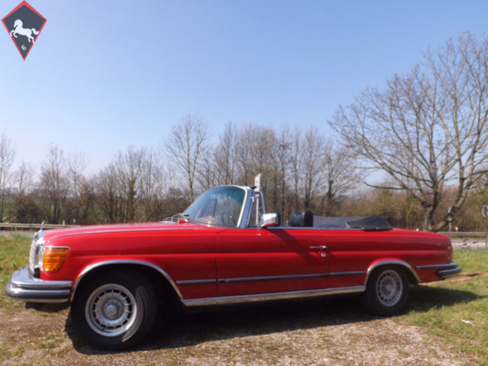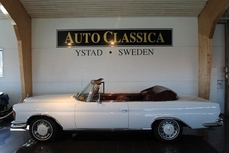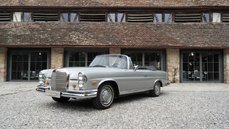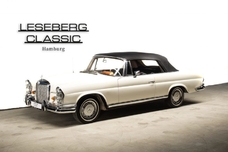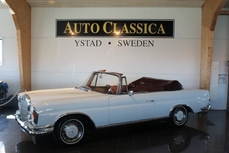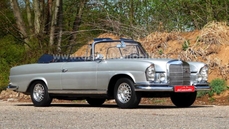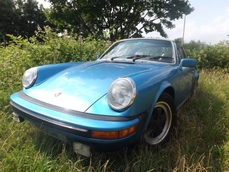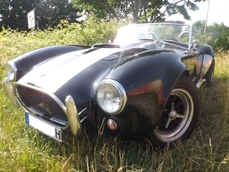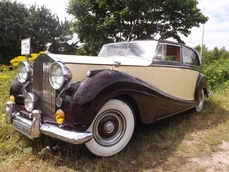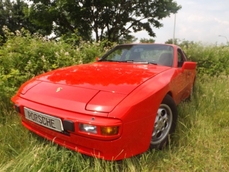Mercedes-Benz 250SE Cabriolet w111 1965
General description :
Unglaublich aber wahr. Dieses Fahrzeug weist mit Sicherheit mindestens zwei Superlative auf!
1) Dieser Mercedes ist ein Einzelstück und wurde auf Kundenwunsch von Mercedes hergestellt und kombiniert einen W111 mit den dominierenden Stilelementen eines W116! Absolut einmalig!
2) Die Kilometerleistung dieses Fahrzeuges beträgt über 2 Millionen Kilometer!!! Mit dem ersten Motor!!! Also "matching numbers" .Im Jahr 1992 verlieh die Mercedes-Benz AG in Untertürkheim dem Besitzer die goldene 1 Mio. Kilometer Urkunde. Danach folgten die nächsten 1.000.000 Kilometer. Der Kilometerzähler im Fahrzeug war völlig überfordert, als die nächsten 1 Mio. Kilometer im Jahr 2014 erreicht wurden. Nicht unerwähnt soll bleiben, dass dieses Cabriolet aus 1. Hand ist. Natürlich gibt es den ersten sog. "Pappedeckelbrief" und alle weiteren relevanten Dokumente, die das belegen, was unglaublich aber wahr ist.
Aber es geht noch weiter: Der erste und einzige Eigentümer dieses aussergewöhnlichen Fahrzeges ist selbst ebenfalls sehr aussergewöhnlich. Als Schauspieler war er der Hauptdarsteller in unzähligen Filmen und nicht nur berühmt sondern auch "berüchtigt". Zu unrecht wurde er in den 70er Jahren des letzten Jahrhunderts als Mörder verdächtigt und füllte mit zahlreichen Berichten die Boulevardpresse im In- und Ausland. Es dauerte lange bis sich seine Unschuld herausstellte und er rehabilitiert wurde. In der Jet-set Schickeria war er also eine berühmte und schillernde Persönlichkeit. Sein Mercedes war immer dabei und auf vielen Pressefotos waren er selbst, sein Mercedes, schöne Frauen und berühmte Politiker zu sehen. Ein sog "Mann von Welt". Noch heute lebt er in seiner spanischen Luxusvilla und geniesst das Leben als "gealterter Playboy", jetzt aber ohne seinen geliebten Mercedes. Er ist häuslich geworden, kann und möchte seinen Wagen aus gesundheitlichen Gründen nicht mehr fahren und bietet ihn hiermit zum Kauf an. Ideal als Highlight einer Auto- oder Mercedes Sammlung oder als perfektes Sommer Cabriolet, was dieser Mercedes auch am besten kann und nach 2.000.000 Km zweifelsohne eindeutig bewiesen hat.
WENN NOCH WEITERE FAHRZEUGE DIESER ART INTERESSANT SEIN SOLLTEN BITTE EINFACH "FANTASTISCHE FAHRZEUGE" GOOGLE´N. WIR SIND SOFORT DER ERSTE EINTRAG !
Telefonischer Kontakt wird sofort bearbeitet. E-mails dauern etwas länger. (Bitte eigene Telefonnummer angeben)
Verkauf im Kundenauftrag ! Irrtümer vorbehalten.
https://home.mobile.de/MICHAEL-FROEHLICH#des_208082386
1965 Mercedes-Benz 250SE Cabriolet w111 is listed sold on ClassicDigest in Rudolf-Diesel-Straße 2DE-40822 Mettmann for €55000.
Car Facts
Car type : Car Make : Mercedes-Benz Model : 250SE Cabriolet w111 Engine size : 2.5 Model Year : 1965 Sub type : Convertible Location : Rudolf-Diesel-Straße 2DE-40822 Mettmann
Sold
Seller Information
Sold
People who viewed this Mercedes-Benz 250SE Cabriolet w111 also viewed similar Mercedes-Benz listed at ClassicDigest
Other cars listed for sale by this seller
About Mercedes-Benz
In the annals of automotive history, the journey of Mercedes-Benz is a tale that unfolds with the ingenuity of its founding pioneers. In the year 1886, Karl Benz crafted the Benz Patent Motorwagen, a creation that would go down in history as the world's inaugural automobile. Unbeknownst to him, this moment marked the genesis of what would evolve into the most illustrious premium car manufacturer globally. The financial underpinning of this pioneering venture, interestingly, was provided by Karl Benz's wife, Bertha Benz, demonstrating a remarkable partnership that would set the tone for Mercedes-Benz's legacy.A parallel narrative emerged not far away, as Daimler-Motoren-Gesellschaft, founded by Gottlieb Daimler and Wilhelm Maybach, entered the scene. In 1901, they unveiled their automobile under the now-famous moniker "Mercedes," meaning "godsend" in Spanish. This name was bestowed upon the car at the behest of Emil Jellinek's daughter, the distributor for Daimler-Motoren-Gesellschaft. The wheels of innovation were set in motion.
Fast forward to 1926, a pivotal year that witnessed the merger of Daimler with Benz & Cie., culminating in the birth of Daimler-Benz. The amalgamation saw the adoption of "Mercedes-Benz" as the distinguished trademark for their automobiles, fusing the legacies of two visionary entities into one.
Contrary to perceptions of conservatism, the trajectory of Daimler-Benz unfolds as a chronicle of industry firsts. From the introduction of the honeycomb radiator to the float carburetor, and the pioneering implementation of four-wheel brakes in 1924, Daimler-Benz consistently pushed the boundaries of automotive innovation. The diesel-powered Mercedes-Benz 260 D in 1936 marked the inception of diesel engines in passenger cars. The iconic Mercedes-Benz 300SL Gullwing made history as the first car with direct fuel injection, albeit the Gutbrod's tiny 2-stroke engine can claim precedence.
Safety innovations became a hallmark, with Béla Barényi's patented safety cell design in the "Ponton"-models in 1951, featuring front and rear crumple zones. The W116 450SEL 6.9 saw the introduction of the Anti-Lock Brake system (ABS), another pioneering safety feature. From the first production airbags and beyond, the legacy of "firsts" continued to be etched into the fabric of Daimler-Benz.
Over its centennial journey, Mercedes-Benz has not merely produced cars but has sculpted automotive icons. The SSKL, 710 SSK Trossi Roadster, 770K Grosser, 540K Spezial Roadster, 300SL Gullwing, w100 600 Pullman, w111 280SE 3.5 Flachkühler, w113 230SL Pagoda, w109 300 SEL 6.3, and w201 2.3-16 Cosworth stand testament to the brand's commitment to engineering excellence.
The roaring Silver Arrows, or "Silberpfeile," including the W 25, W 125, W154, W165, and W196, created a legacy of dominance on the racetrack. These machines were not merely cars; they were expressions of precision, speed, and an indomitable spirit that left their competitors in the dust.
As Mercedes-Benz marches into the future, it does so not just as an automaker but as a custodian of a legacy, a torchbearer of innovation, and a beacon of automotive excellence. The road ahead is sure to witness the continued fusion of cutting-edge technology, timeless design, and an unwavering commitment to setting new standards in the world of automobiles.
One luminary figure who left an indelible mark was Béla Barényi, often heralded as the "father of passive safety" for his pioneering work in safety engineering. His patented safety cell design, featuring front and rear crumple zones, became a hallmark of Mercedes-Benz's commitment to occupant safety, setting new standards that reverberated throughout the automotive world.
Moving through the chronicles, the collaborative genius of Wilhelm Maybach, alongside Gottlieb Daimler, laid the foundation for Daimler-Motoren-Gesellschaft. Their innovations not only birthed the first Mercedes but established a culture of relentless pursuit of technological excellence that remains integral to Mercedes-Benz's DNA.
In the post-merger era of 1926, Ferdinand Porsche emerged as a prominent figure within Mercedes-Benz. His work on the Mercedes-Benz S-Type, a supercharged race car, garnered acclaim and set the stage for a legacy that extended far beyond the marque. Porsche's impact would later extend to his eponymous company, but his influence at Mercedes-Benz during those formative years was pivotal.
As the 20th century progressed, the legendary Rudolf Uhlenhaut emerged as a key figure. Uhlenhaut, an accomplished engineer and the driving force behind the iconic Silver Arrows, played a crucial role in Mercedes-Benz's dominance in motorsports. His engineering prowess and attention to detail were instrumental in creating some of the most formidable racing cars of the era.
In the latter half of the century, figures like Bruno Sacco, the head of design at Mercedes-Benz from 1975 to 1999, left an indelible imprint on the brand's aesthetic identity. Sacco's design philosophy, characterized by clean lines and timeless elegance, shaped iconic models like the W126 S-Class and the W201 190E, solidifying Mercedes-Benz's reputation for luxury and sophistication.
The narrative would be incomplete without acknowledging the contributions of engineers like Hans Scherenberg, whose leadership in the 1970s ushered in a new era of technological innovation at Mercedes-Benz. Scherenberg's tenure saw the development of groundbreaking technologies, including the Anti-Lock Brake system (ABS) and the introduction of airbags in production cars.
